Nature Notes: Mountains and Fungi
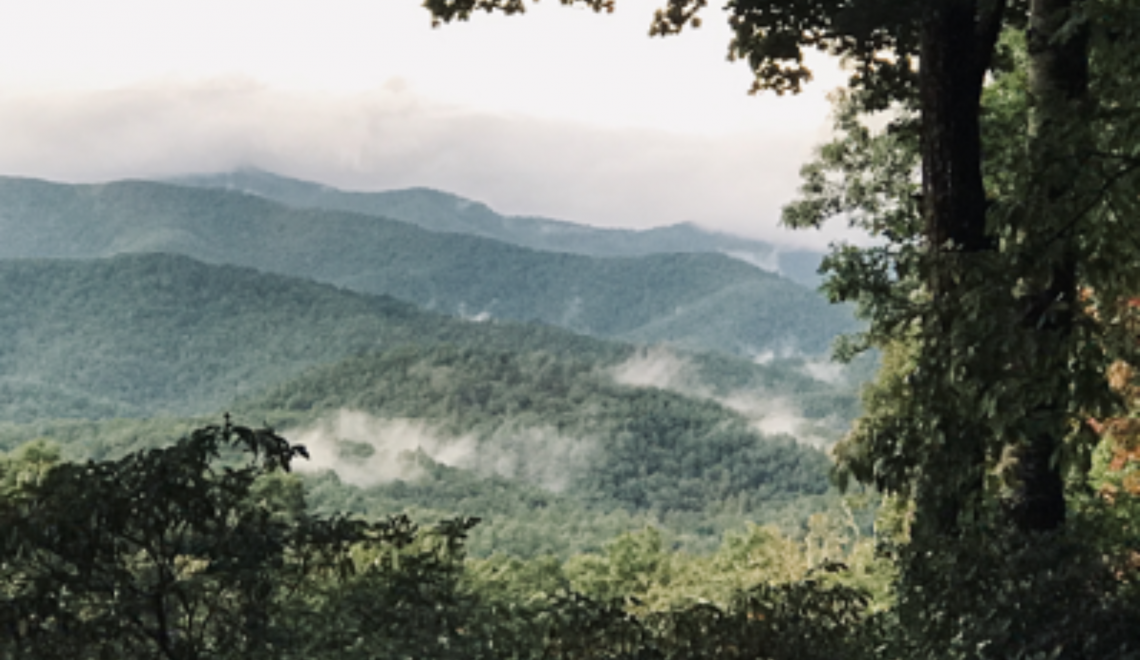
October 2020
By: Linda Martinson
It is mid-October, and there is still a pandemic and a contentious election coming up. When I need to get a grip, I contemplate the mountains which gives me a soothing, this-too-shall-pass feeling. Here in Western North Carolina, we live in one of the oldest mountain ranges in the world: the Blue Ridge Mountains. They are 1.2 billion plus years old, but they are not very high because although they have been uplifted repeatedly, they also have been persistently eroding for millions of years.
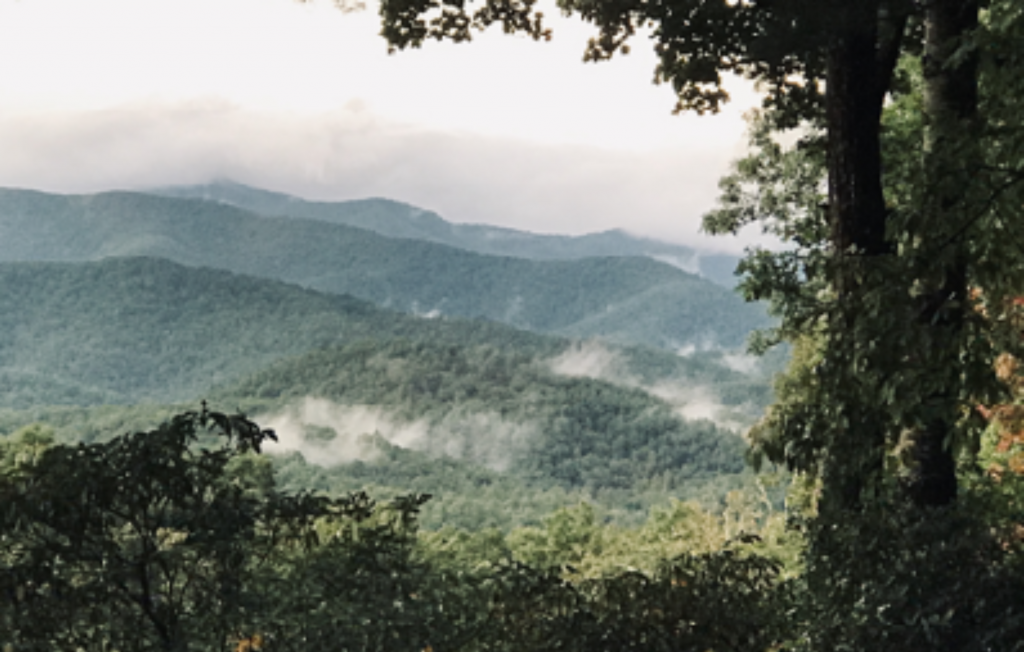
The Appalachian Mountains were uplifted and then eroded in four different periods. These cycles of mountain formation and erosion resulted in ancient and persistent mountain ranges with significant biodiversity. The first cycle of mountain building in what is now the Appalachians, the Grenville orogeny, occurred a billion years ago when the only organisms on Earth were bacteria…at least that was the accepted assumption until recently. The long mountain chain was estimated to be about 20,000 feet high, but because there were no land plants to hold the soil, the wind and water steadily and relatively quickly eroded the mountain range.
The second cycle of geological mountain range formation, followed again by a significant erosion cycle, was the Taconic orogeny which occurred about 460 to 440 million years ago in most of what is now the northern part of the Appalachians. A great mountain chain formed from the present Piedmont area of the east coast up to eastern Canada, and that long series of mountain building has been described as “collisions that migrated northward like the closing of a zipper.” The sediments from the erosion of that massive mountain chain then spread southward throughout what is now the Appalachians. During that era, the first coral reefs emerged in the oceans and algae was the only multi-cellular plant. There was no complex life on land during this period, but by the end of Taconic orogeny there were some invertebrates in the oceans e.g., shellfish and some primitive fish and well before the Taconic orogeny, about 600 million years ago or even earlier, there were also some extant species of oceanic fungi.
Fossil records are not definitive, but original DNA analyses suggested that all fungi are descended from one common ancestor perhaps as early as 600 million years ago. These early fungi lived in the oceans and had slender threadlike microscopic appendages, flagella, that enabled them to move about in the water. However, quite recent research, published in Nature 22 May 2019, reports finding evidence of ur-fungi fossils (the prefix “ur” means “most ancient”) in billion-year-old rocks in arctic Canada. This indicates that fungi may have indeed been extant during the Grenville orogeny which occurred a billion years ago. So it is possible that fungi had moved from the oceans to land perhaps as early as a billion years ago.
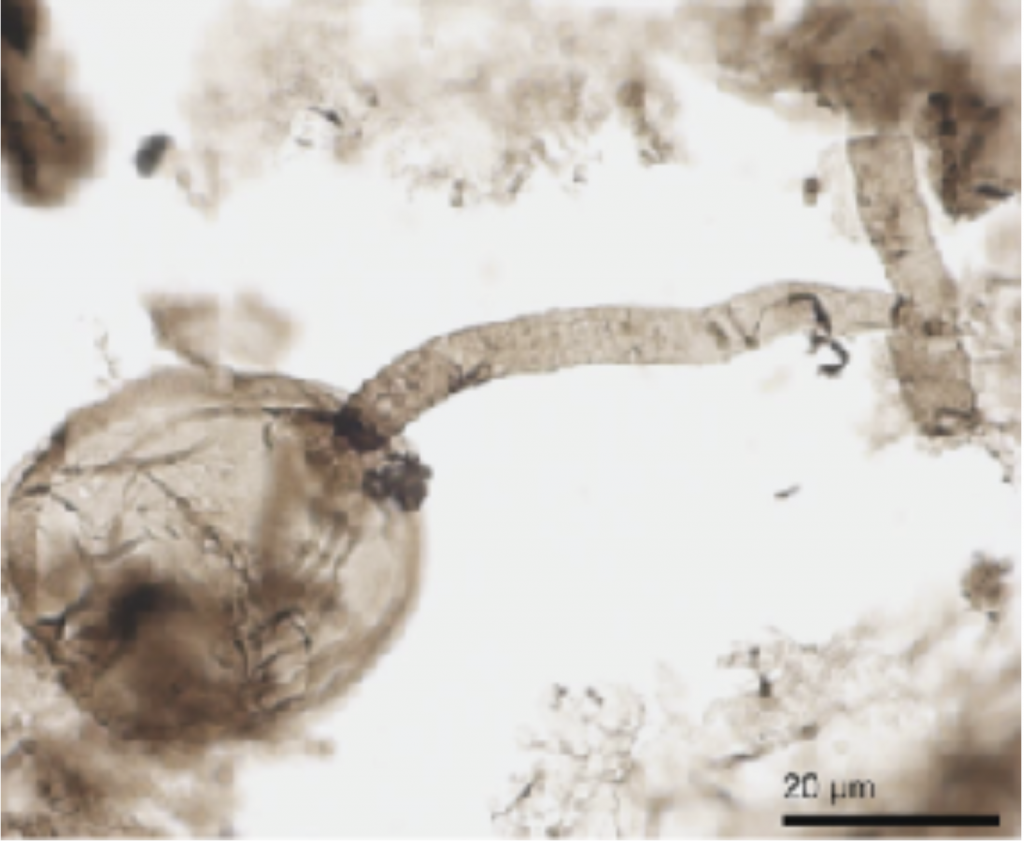
By about 250 million years ago, fungi became abundant in many areas, based on the fossil records, and may have been the dominant forms of life on Earth at that time. (More about fungi later…)
The third mountain building/erosion cycle, the Acadian orogeny, occurred between 420 and 370 million years ago, near the beginning of a major period of mountain building on nearly every continent, again followed by significant erosion. The sea level was also rising during that period, and eventually, most of what is now North America was under water starting from what is now the Gulf of Mexico and spreading northward. By the Paleozoic era, around 360 million years ago, the climate was warm and wet, and there were forests on land comprised of giant club mosses; giant ferns; and early trees. For millions of years, these plants died and filled the swampy waters that covered most of the area that is now the Central Appalachians mainly in West Virginia and Pennsylvania. This is referred to as the Carboniferous geological period, from about 360 to 300 million years ago, during which some of the richest coal beds in the world formed.
The major event that shaped today’s Appalachian mountains was the Alleghanian orogeny that occurred around 330 million years ago when the continent of Africa smashed into North America forming the super-continent of Pangea centered on the equator and surrounded by the super-ocean Panthalassa. That mighty collision also created mountains in Appalachia that are estimated to be as high as 26,000 feet, comparable to the highest mountains in the world today. Since then, during the past 330 million years, the Appalachian Mountains have been eroding to about their current maximum of 6,684 ft (Mount Mitchell in North Carolina) and average height of around 3,000 ft.
Throughout this geological history of significant and rather sudden mountain formation and volcanic events, our planet has also shifted between greenhouse conditions and “icehouse” conditions followed by severe extinction events. There have been five major extinction events in the past 450 million years, and the first four of these are generally linked to geochemical changes such as mountain formations, for example in the Appalachian range, or volcanic eruptions. These are considered mass extinctions because huge numbers of species disappeared in a relatively short period of time. Of all the species that have existed on Earth, it is estimated that 99.9% are now extinct and many of them perished during these five mass extinction events.
Ordovician-Silurian extinction – 444 million years ago
Late Devonian extinction – 383-359 million years ago
Permian-Triassic extinction – 252 million years ago (the largest extinction event)
Triassic-Jurassic extinction – 201 million years ago
Cretaceous-Paleogene (K-T) extinction – 65 million years ago
Research indicates that changes in the levels of atmospheric carbon dioxide (CO2) were the major drivers of these first four extinction events (although there are still some open questions about the Devonian extinction) caused by shifts in Earth’s climate from greenhouse to “icehouse” conditions, and that these CO2 changes were the direct results of the major mountain formation and volcanic events. For example, mountains were formed and rose dramatically as the crustal plate underneath what is now the Atlantic Ocean pushed against the eastern side of North America during the Alleghanian orogeny. This violent shift lifted huge quantities of ancient silicate volcanic rock up from the seafloor onto the land. This volcanic rock weathers quickly, reacting with carbon dioxide in the atmosphere, and then disintegrates relatively quickly trapping the carbon in the resulting sediment which is eventually deposited into the world’s oceans.
Silicate volcanic rock reacts with CO2 and water and disintegrates quickly. The carbon from the captured CO2 is trapped in the resulting sediment which significantly reduces the amount of CO2 in the atmosphere. A vast amount of volcanic rock was eroded away and deposited in the oceans when the mountains were reduced by 20,000 feet during the Alleghanian orogeny approximately 330,000 years ago.
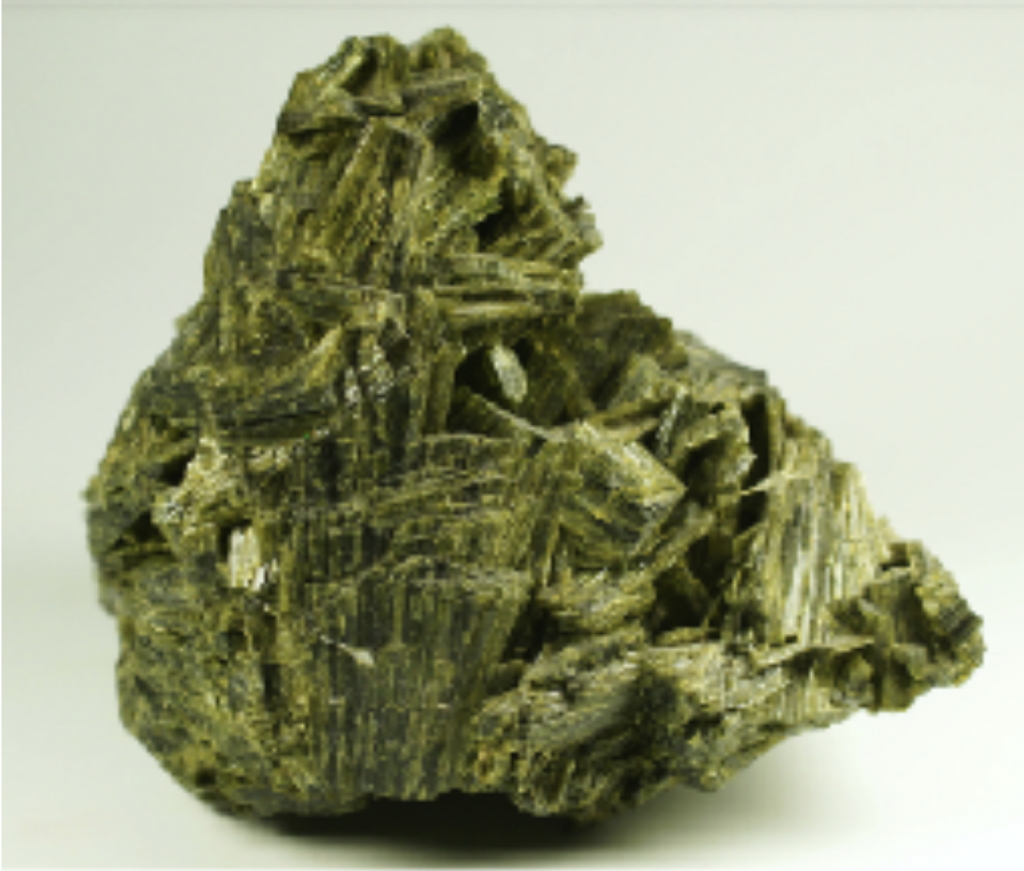
Although there are competing theories, according to studies conducted by scientists at The Ohio State University, most of this weathering/erosion of the Appalachian mountains or other mountain following mountain formations or volcanic events resulted in a significant decrease in atmospheric CO2. As CO2 and water reacted by disintegrating newly exposed volcanic rocks, this chemical reaction weathered away significant parts of the Appalachians consuming large amounts of CO2 from the atmosphere. As the water evaporated, carbon was trapped in huge amounts of sediment and the global climate shifted into from a warm climate into an ice age.
This geochemical shift took only about 7 to 8 million years after the mountains were formed, a fairly rapid shift by geochemical standards.
Fossil records reliably indicate that each time there was major mountain building geological event followed by weathering and erosion, the climate moved from a greenhouse era to an ice age causing mass extinctions. For example, the Ordovician period started out warm with high sea levels worldwide, but it ended cold, with low sea levels and glaciers covering both poles and parts of all the continents. This Ordovician ice age happened approximately 445 million years ago and resulted in the extinction of 85% of all species on Earth.
Our planet has shifted between greenhouse conditions and icehouse conditions throughout its history, and research strongly suggests that decreases in atmospheric CO2 levels due to the erosion/weathering of volcanic rocks uplifted during mountain formation or volcanic eruptions are a key cause and a major driver of these climate changes. The assumption that CO2 is a major driver of climate is now widely accepted by scientists. As atmospheric CO2 levels drop, the climate of Earth gets cold and as atmospheric CO2 levels rise, the climate grows warmer.
There are causal variations, however. For example, although we are currently living in an ice age caused by mountain formation in the Himalayans, we are now in a warmer period within this ice age with CO2 levels worldwide rising slightly instead of remaining low. Most scientists believe this is because humans have raised CO2 atmospheric levels by persistently burning fossil fuels, mostly coal from the Carboniferous geological period of 360 – 300 million years ago, resulting in global warning.
What about the fifth major extinction event which happened about 65 million years ago? The most accepted hypothesis for the Cretaceous-Paleogene (K-T) mass extinction event is that was caused by the environmental consequences from a large asteroid 6 to 9 miles wide hitting Earth near what is now Mexico’s Yucatan Peninsula. This catastrophic event caused the sudden extinction of 75% of the plant and animal species on Earth. There was a sudden massive release of CO2 into the environment causing rising sea levels and severe acidification of the oceans which devastated the global environment, mainly through a lingering winter impact which stopped photosynthesis in plants and plankton, and created an almost complete ecological collapse of life on Earth, especially of the dinosaurs. Dinosaurs dominated Earth’s landscapes for 150 million years, and they lived on what is now all seven continents and developed into what is estimated to be 1,100 species. With the asteroid strike, virtually all dinosaurs perished; the reign of reptiles ended; and the dominance of mammals on Earth began. The K-T mass extinction is sometimes described as the replacement of dinosaurs by mammals, eventually humans.
The K-T extinction did provide significant evolutionary opportunities and many species flourished with rather adaptive radiation which is defined as “sudden and prolific divergence into new forms and species within disrupted and destroyed ecological niches.” Mammals in particular diversified and evolved new forms following the mass extinction e.g., horses, whales, bats, and primates. The only surviving group of dinosaurs was primarily avian species that radiated into all modern species of birds.
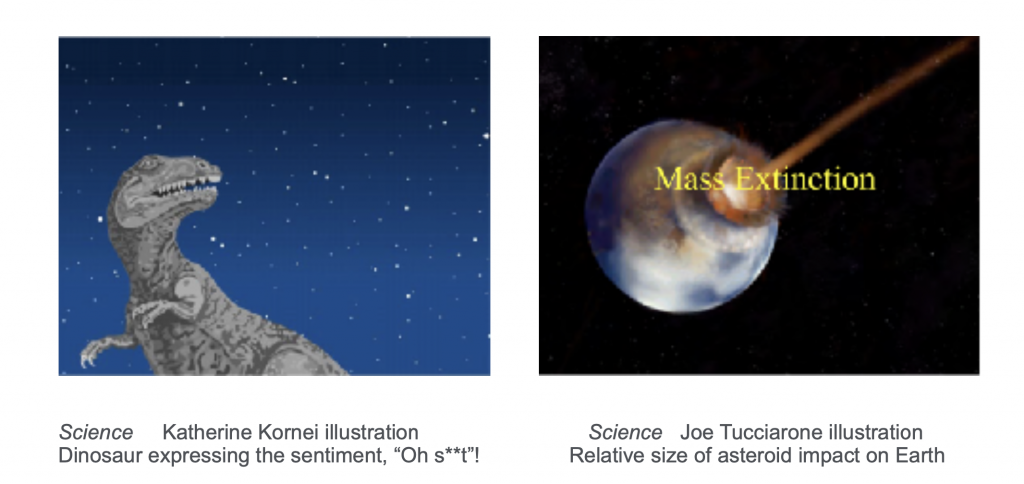
What happened to extant fungi species during the K-T extinction? Many fungi species were wiped out during the K-T extinctions, but fossil evidence also indicates that a “fungal world” formed dominating the environment for a few years after the K-T boundary event. For example, microfossils from that period immediately after the asteroid collision indicate a significant increase in fungal spores long before there was a corresponding increase in any plant seeds. The “world of fungi” occurred because the fungi that dominated then were saprobes, microscopic fungi that don’t require sunlight to survive and that thrive on rotting and decomposing plant, insect and animal remains which were, of course, plentiful following a mass extinction. A dominance of saprobic fungi indicated by microfossil remains also happened after other mass extinction events, including the Permian-Triassic extinction, the largest known during which 90% of all species on Earth were lost. Note: there is some debate about the causes of the Triassic extinction, but many scientists contend that this event, too, was caused by climate change and rising sea levels resulting from the sudden release of large amounts of carbon dioxide.
Apparently, fungi have been flourishing for perhaps as long as a billion years and have survived and even flourished through five mass extinctions. At many times during this long history, fungi may have been the dominant life forms on Earth. There are 144,000 documented known species of fungi, but it is estimated that there are probably between 2.2 and 3.8 million species. Fungi species have their own kingdom, but a fungus (singular of fungi) is an organism not easily defined or even easy to find.
Here is one description from the Encyclopedia of Food Microbiology: “The word ‘fungus’ is used to cover a huge range of shapes and types of cellular, coenocytic, spherical, filamentous, simple, complex, mobile, immobile, parasitic, symbiotic, saprophytic, microscopic, and macroscopic organisms, which makes any attempt at definition difficult.”
The short explanation for this difficulty is that we haven’t identified many fungal species, and we don’t really know much about the ones we have identified because we can’t see most fungi.
Fungi include yeasts, rusts, smuts, mildews, molds and mushrooms, and they are “among the most widely distributed organisms on Earth and are of great environmental and medical importance.” They are primarily composed of water (69-90%), carbohydrates, proteins, and lipids and the three most important groups of fungi are molds, yeasts and mushrooms. They are also the mold on bread; the antibiotic prescribed for infections; and they can cause infections.
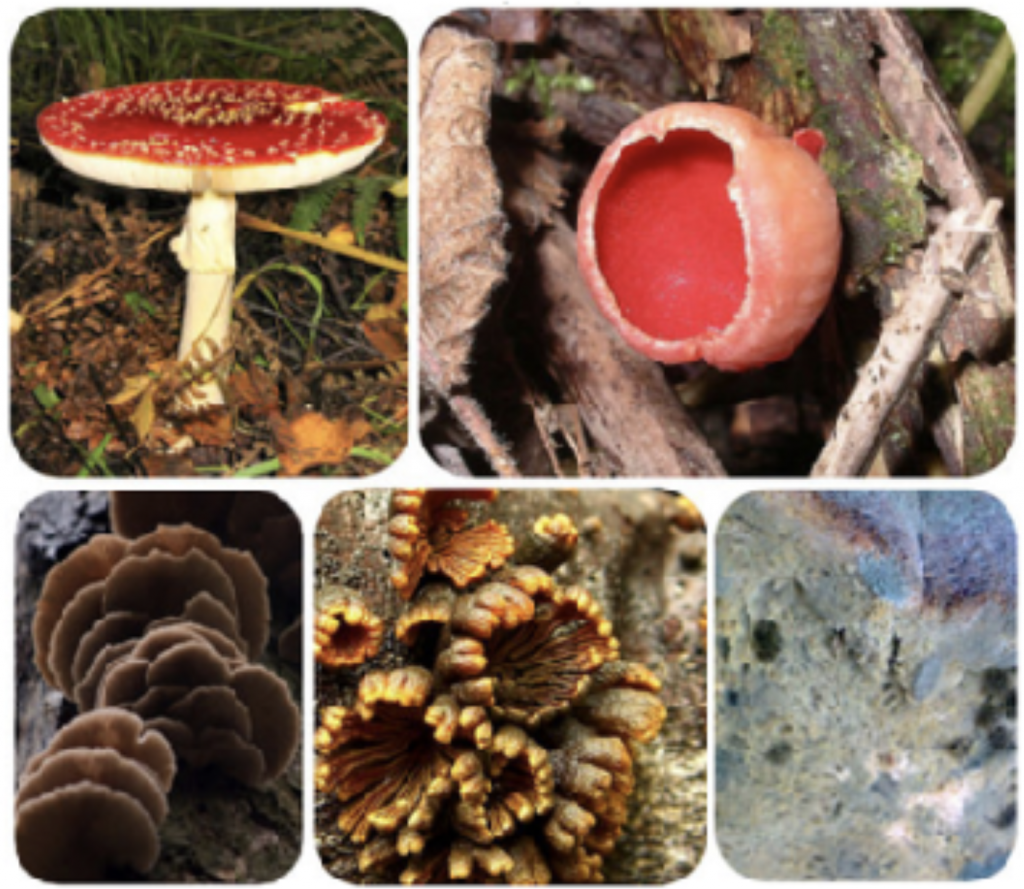
Fungi live on surfaces both in and below soil, in the air, in water, in deep oceans and even inside solid rock, and 90% of all plants depend on fungi for minerals. They live in our bodies and we breath fungal spores every day. And fungi are not just “there” in these significantly variable places, they are structural, i.e., fungi are an integral component of where they are. For example, https://www.sciencemag.org/news/2018/09/fungi-live-cockroaches-oil-paintings-and-other-bizarre-places-come-light-new-report
Plants make their own food through photosynthesis; animals find and ingest their food; but fungi put themselves into food by releasing digestive enzymes into…something, could be cigarette butts; an oil spill; an animal carcass; or dead leaves. Fungi “eat” by releasing digestive enzymes into something, usually dead, and digest it externally.
Many fungi are free-living in soil or water, but other species form parasitic or symbiotic relationships with plants or animals. Lichens, for example, are not a single organism but rather two organisms living together intimately and functioning as a single unit. A lichen is actually a “lichenized” fungus composed mainly of fungal filaments but with algae or bacteria packed in there, too.
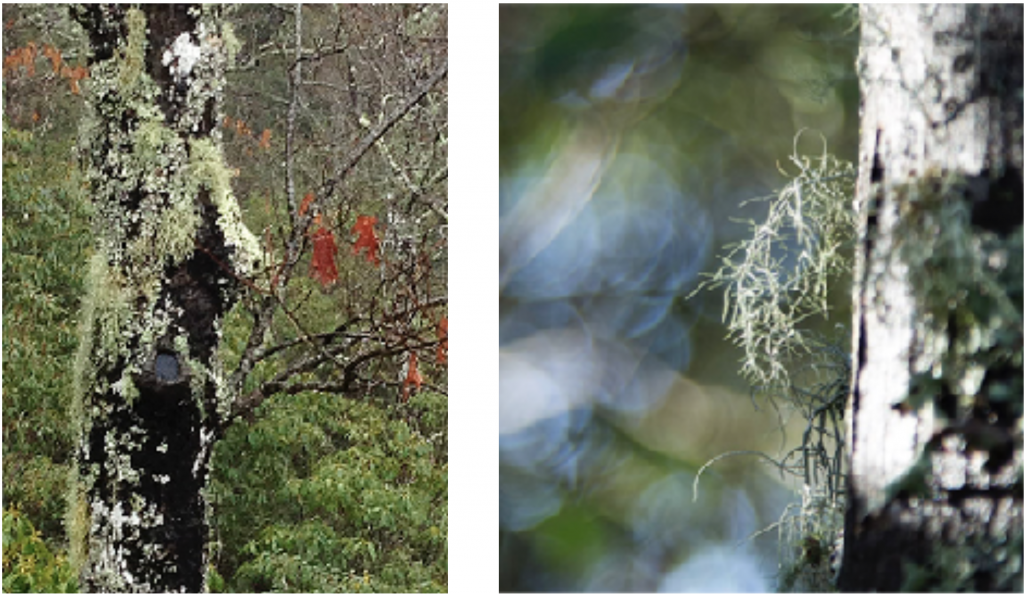
Fungi, like plants, are promiscuous or stated more delicately, collaborative i.e., they readily form relationships, hybridize, and even merge with other organisms. For most fungi, hyphae—their long, branching filaments—are the building blocks for a fungus and mycelium refers to the collection of hyphae in a fungus. Fungi reproduce asexually by fragmentation, budding, or producing spores, and fragments of hyphae can grow new colonies of fungi quite rapidly. Mycelium has been described as “the living seam by which much of the world is stitched into relation.” (Sheldrake 2020)
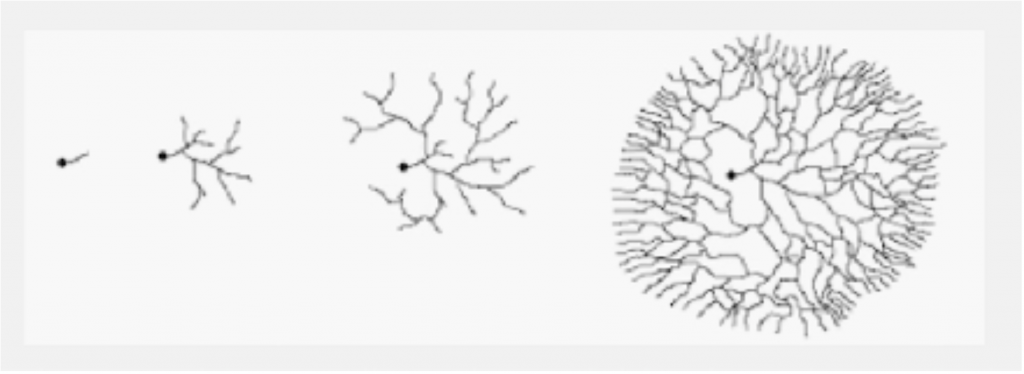
Representation of mycelium growing rapidly from a fungal spore and hypha fragment Australia National Herbarium drawing
And wait there’s more!! This newsletter is only a brief introduction to the wonders of fungi. If you are intrigued, even enthralled, and want more information and entertainment, obtain this book immediately: Entangled Life: How Fungi Make Our Worlds, Change Our Minds & Shape Our Futures by Merlin Sheldrake, May 2020.
Sheldrake is a mycologist who studies underground fungal networks. He writes in his book about two fast-growing fields of biological inquiry. One is the many sophisticated problem-solving behaviors that have evolved in brainless organisms outside the animal kingdom e.g., fungi or slime molds. The second field of inquiry is the way we think about microscopic organisms —or microbes—that cover every inch of our planet. This is particularly intriguing now that we know that we carry around more microbes in our bodies than we do our own cells. As one reviewer wrote, Sheldrake writes about these questions with “ebullience and precision” and “moves smoothly between stories, scientific descriptions, and philosophical issues”. Rob Dunn, a biologist who also writes compelling books about nature (e.g., Never Home Alone: From Microbes to Millipedes, Camel Crickets, and Honeybees, the Natural History of Where We Live) wrote about Entangled Life, “This book rocked me into remembering that nature, especially fungal nature, is big and encompassing and creative and destructive. It reminded me that fungi are, like the Universe, sublime.”
And here is a “plant of the month” selection. I had not seen this plant at Richland Ridge before my daughter spotted it while we were “Pandemic walking” in early October.
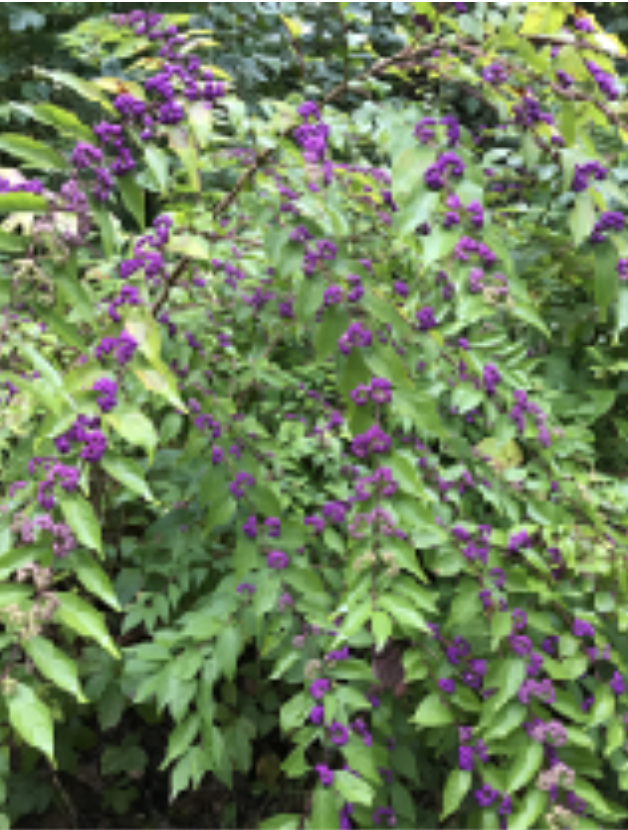
This is an American Beauty-berry bush Callicarpa americana L, a native plant in the lower 48 US states. It generally grows 3-5 feet tall and often just as wide, but sometimes grows as high as 9 feet. Its most striking feature is its showy clusters of glossy bright purple berries that often remain after the leaves have fallen. The flowers are easily missed. They are small and pink, blooming in close clusters at the bases of the leaves. The berries and seeds are important foods for many birds.
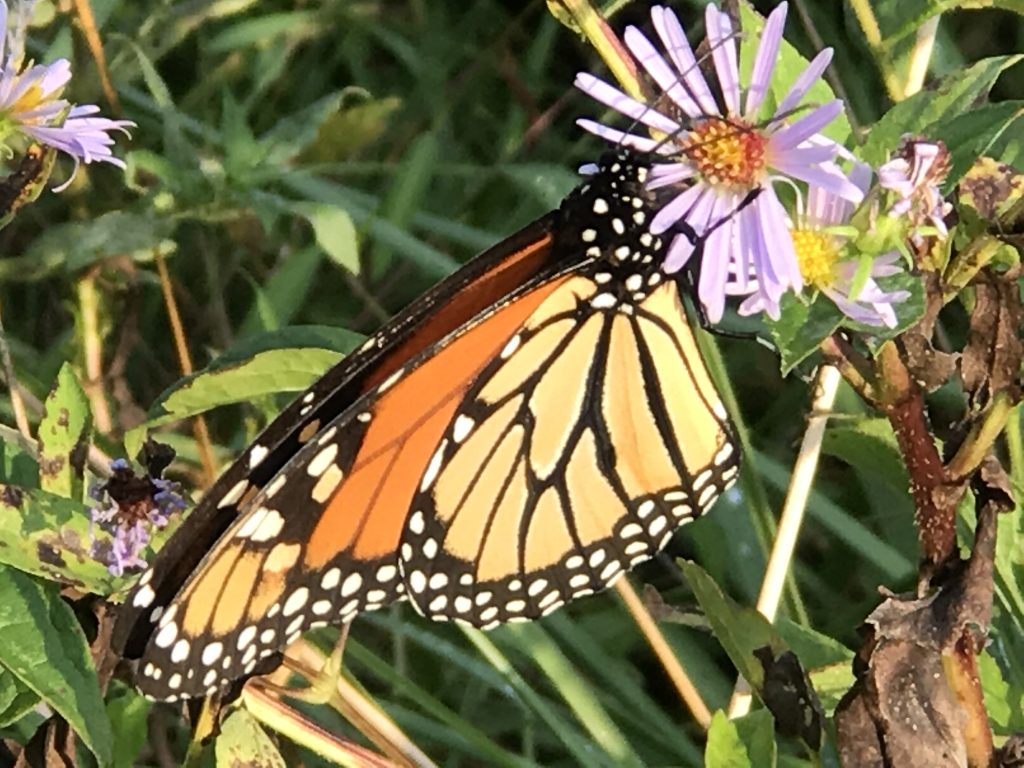
And….Another successful monarch migration.
Other references:
Reimagining Dinosaurs. National Geographic October 2020
Joel, Lucas (21 October 2019). “The dinosaur-killing asteroid acidified the ocean in a flash: The Chicxulub event was as damaging to life in the oceans as it was to creatures on land, a study shows”. The New York Times
Stetka, Bret. April 16, 2016 “The Human Body’s Complicated Relationship with Fungi” NPR
“Fantastic Fungi”. The University of Oklahoma Citizen Science Collection Program. 2014.
And a joke to help remember how to pronounce “fungi”:
A mushroom walked into a bar and ordered a drink. “I’m sorry,” said the barkeeper, “we don’t serve mushrooms.” The mushroom said, “But why not, I’m a fun guy!”

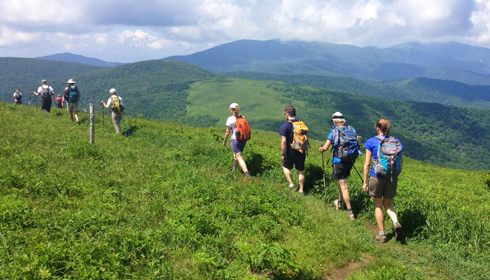



46 comments